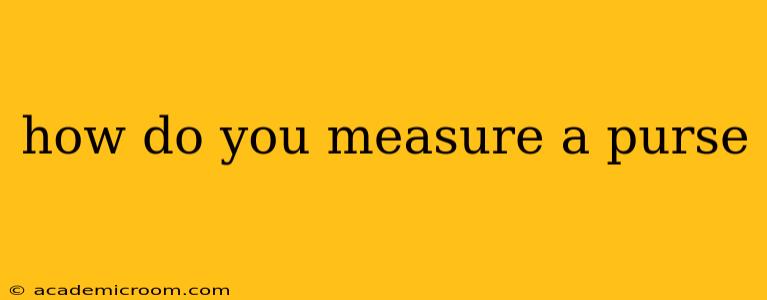How Do You Measure a Purse? A Comprehensive Guide to Sizing Up Your Handbags
Choosing the perfect purse involves more than just aesthetics; the right size is crucial for functionality. Knowing how to accurately measure a purse ensures you find one that perfectly fits your needs and lifestyle. This guide will walk you through the process, covering different measurement techniques and addressing common questions.
What Tools Do You Need?
Before you start measuring, gather these simple tools:
- Flexible Tape Measure: A soft tape measure is ideal as it conforms to the curves of the purse. A rigid ruler might be inaccurate on curved surfaces.
- Pen and Paper: To record your measurements.
- Purse: Obviously!
How to Measure the Dimensions of Your Purse:
The standard measurements for a purse include height, width, and depth. Here's how to obtain each measurement:
-
Height: Measure the purse from the top of the handle (or top edge if it doesn't have handles) to the bottom of the purse. Hold the tape measure straight and taut.
-
Width: Measure the widest part of the purse at its base. This is usually across the bottom, but if the purse flares out higher up, measure the widest point.
-
Depth: Measure the purse from front to back at its base. This determines how much the purse can hold.
Illustrative Example:
Let's say you're measuring a tote bag. You might find measurements like this:
- Height: 12 inches
- Width: 15 inches
- Depth: 6 inches
You can then express these measurements as "12" x 15" x 6"
Beyond the Basics: Considering Other Measurements
While height, width, and depth are fundamental, consider these additional aspects for a complete understanding of your purse's size:
- Strap Length: Measure the length of the strap from where it attaches to the purse to the end. This is crucial for shoulder bags or crossbody bags.
- Handle Drop: For purses with handles, measure the drop—the vertical distance from the top of the handle to the top of the purse. This determines how the bag will sit on your shoulder or in your hand.
- Pocket Dimensions: Measure the interior pockets for organizational purposes. Note the height, width, and depth of any zippered or open pockets.
Addressing Frequently Asked Questions (FAQs):
How do you measure a purse online?
Online retailers often provide dimensions in the product description. Look for details like height, width, and depth, usually expressed in inches or centimeters. If unsure, contact customer service for clarification. Also, pay attention to customer reviews; sometimes shoppers will comment on size and whether it aligns with expectations.
What size purse is best for everyday use?
The ideal size for everyday use depends on individual needs and lifestyle. A medium-sized tote or crossbody bag that can comfortably hold essentials like a wallet, phone, keys, and a small makeup bag is often a good choice. However, if you regularly carry a laptop or tablet, you'll likely need a larger bag.
How do you measure a purse with unusual shapes?
For purses with unconventional shapes, take measurements at their widest and highest points. You might need to take multiple measurements to accurately represent the bag's size and shape. Describing the shape (e.g., crescent, trapezoidal) along with the measurements can also be helpful.
How can I compare purse sizes effectively?
When comparing purses, focus on the key dimensions—height, width, and depth. Consider your typical daily carry and choose a bag with measurements that comfortably accommodate your belongings. Don't just rely on pictures; always check the detailed dimensions provided by the seller.
By carefully measuring your purses and using these tips, you’ll be able to select the perfect bag every time, ensuring both style and practicality. Remember that paying attention to detail and considering individual needs are key to finding the ideal size for any occasion.
